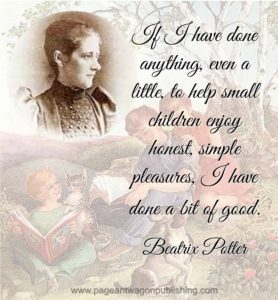 There is something delicious about writing the first words of a story. You never quite know where they’ll take you. Mine took me here, where I belong.
There is something delicious about writing the first words of a story. You never quite know where they’ll take you. Mine took me here, where I belong.
― Beatrix Potter
As a child, Beatrix Potter often wondered where she belonged. It would be many years and more than her fair share of trials before her life’s path brought her to where she belonged.
In keeping with the child rearing trends of the upwardly mobile classes in Victorian England, Beatrix’s parents entertained limited interaction with their children until they came of a civilized age. A nurse was tasked with the daily care of Beatrix and her younger brother, Bertram. In her teen years a governess appointed to mold the girl Beatrix into a lady became her companion, while Bertram went off to boarding school in the elementary years, to begin his grooming for the business world.
On any given evening, as a child, Beatrix would sit forlorn in the third-floor nursery of her family’s London townhouse. Nurse delivered dinner. Beatrix ate alone, as usual. After dinner, Beatrix would bathe and dress for bed before saying “goodnight” to Mr. and Mrs. Potter in the drawing room. Perhaps Mother would inquire about her studies under the tutelage of Nurse. The Potters did not approve of sending their daughter to school. It was inappropriate within their social circles. Father might ask if she sketched anything new that day. She would answer their questions with formal politeness, curtsy, and retire to bed. The next day would be much the same, providing little society other than interaction with the servants.
And Peter and Benjamin, of course.
They were rabbits, you know. Young Beatrix kept a virtual zoo of animals in her room—from mice to bats to the beloved pet rabbits who eventually became the inspiration for characters in her series of popular children’s stories. As an adult, these little books made her famous, a household name, and a woman of independent means by 1906.
 But until her mid-30s, Beatrix was a woman of her age, living through a time of limited formal educational opportunities for women in all spheres of society. The upper classes were especially protective of daughters whose greatest aspiration was training to marry well and run a household commensurate with her husband’s social profile. However, the Potters were not eager to see their daughter marry once she came of age. Beatrix had become far too important to the smooth running of their household in the wake of an unending stream of chronic maladies. They had no desire to see their daughter live independent of them.
But until her mid-30s, Beatrix was a woman of her age, living through a time of limited formal educational opportunities for women in all spheres of society. The upper classes were especially protective of daughters whose greatest aspiration was training to marry well and run a household commensurate with her husband’s social profile. However, the Potters were not eager to see their daughter marry once she came of age. Beatrix had become far too important to the smooth running of their household in the wake of an unending stream of chronic maladies. They had no desire to see their daughter live independent of them.
The trials of Beatrix’s repressive, stoic early years and early adulthood, raised in this controlling Victorian parenting regime, might have produced a bitter, unimaginative, rebellious woman. Certainly, by today’s standards, some might go so far as to accuse the Potters of child abuse and neglect.
But Beatrix used what freedoms she did have to escape and explore the glories of the flora and fauna—both in her own backyard, and for three months each year, the country estate grounds where the family took their summers. With an unlimited supply of writing and drawing instruments, Beatrix kept a daily journal of thoughts and observations on her excursions and the daily lives of all her pets. She filled pages with companion pencil and watercolor sketches of garden and wildlife. Her superior attention to detail regarding the flora, was countered with a whimsical capturing of animal life—suiting them up well in gaiters, waistcoats, aprons, and bonnets. Interacting with God’s creation cultivated her imagination, bringing balance to her otherwise dull lifestyle.
She could little imagine, though, how this personal passion and retreat in nature as a child would one day feed the childhood literary thirsts of millions around the world. Beatrix bore the prison of her daily routines with a quiet resolve to find a personal happy place to offset her responsibilities to her parents. In that place of ofttimes trial, a world of story, in word and illustration, birthed that captivated the imaginations of generations.
Beatrix Potter’s whimsical story world of talking animals, toys, and nursery rhymes, set in restful English country villages, remain a staple in children’s literature over a hundred years after they were inked. In her lifetime, she came to possess a substantial amount of farmland real estate in the Lake District of England from her earnings, purchasing dozens of ancient farms and woodland acreage. She rescued the land from corporate development that would have displaced the people and forever destroy the restful, idyllic landscape of the English countryside with industrial sprawl.
Upon her death in 1943, these preserved acres of land became the foundation of conservation in the National Trust, safeguarding their historical value, simple beauty, environmental wildlife, and the farm and village culture of the people whose families had lived there for centuries. In addition, she contributed to scientific journals with detailed illustrations for fungus studies, drawn from nature, and in her later years became a notable sheep farmer.
That’s quite a legacy for such a sheltered little Victorian girl. But that repressive soil fertilized her discovery of the only trail available to her from childhood. Trial in her life became a pathway guiding her to her ultimate destiny. Beatrix’s journals and letters leave hints as to how she chose to navigate her life to fulfill her place in the world with contentment, humility, and grace:
- I cannot rest, I must draw, however poor the result, and when I have a bad time come over me it is a stronger desire than ever.
Write. Draw. With passion and resolve. Allow the cathartic nature of creativity to heal through your trials.
- Thank goodness my education was neglected . . .Thank goodness I was never sent top school; it would have rubbed off some of the originality.
Expand the liberating place of self-learning in your life. Own your education. Discover the world around you through self-driven study, observation, critical thought, and experiment to develop original ideas.
- Everything was romantic in my imagination. The woods were peopled by the mysterious good folk. The Lords and Ladies of the last century walked with me along the overgrown paths and picked the old-fashioned flowers among the box and rose hedges of the garden.
Cultivate your imagination regarding romantic ideals—perfect models of life, principles, and moral values that celebrate peace, goodness, and beauty (Philippians 4:8). Such things, presented whimsically in Miss Potter style, allow a place of escape for mind and heart in troublesome seasons. It also satisfies, to an extent, the desire to see paradigm ideals manifest in a story of substance. The Christian fiction writer understands this to be the seedbed of a story-world—creating place where the protagonist’s best outcomes might be realized, and readers might find something noble to ponder and relate to in their own lives.
- Believe there is a great power silently working all things for good, behave yourself and never mind the rest.
Live a self-disciplined life knowing that, no matter what, all things work together for good and trials can become the trails that lead you onto God’s purposes for your life.
What many people don’t know is that The Tale of Peter Rabbit, the classic that started it all, was actually a little story Beatrix wrote in a letter to the sick child of her former governess with whom she remained close. It was designed to cheer the little invalid and his siblings with a handful of illustrations and the familiar text we all remember of a very naughty rabbit who squeezes under the gate into Mr. MacGregor’s garden in clear defiance of his mother’s instructions. Encouragement to publish the work moved her to seek out a publisher, only to be turned away multiple times. She was a woman, after all. No matter, she would self-publish!
With some savings of her own, she financed the publication of 500 copies of the book with exact specifications through the Frederick Warne Company—the same company that still holds all the rights to Miss Potter’s work today. It sold out of the bookstore where it was placed in short order, smoothing the pathway for Beatrix to take her place as a shining star in children’s literature and illustration. Her legacy. Her destiny. Precisely where she belonged.
Journal Prompt: Make a list of painful periods in your life when you felt repressed or limited due to circumstances. Write down the life lesson you learned living through each season of trial. How have difficult times in your life informed your writing? How did a personal trial, setback, or disappointment become a pathway to greater things in your life? How have you used negative experiences to add dimension to plot or characters in your stories? Are you where you belong? Journal your answers.
TWEET: #BeatrixPotter and Peter Rabbit, birthed out of repression and sickness. Happy endings to sad stories; how writers thrive in trial and limitations. @misskathypwp Click To Tweet
TWEET:#Women Writers in Life and Letters—Beatrix Potter: From Pain to Pen—When Trials Pave the Trail to a Life Destiny @misskathypwp Click To Tweet
Recommended Reading: Beatrix Potter: A Life in Nature, by Linda Lear, © 2016 St. Martin’s Griffin
Writer-speaker, Kathryn Ross, ignites a love of literature and learning through Pageant Wagon Productions and Publishing. She writes and publishes homeschool enrichment and Christian living books for home, church, and school. Her passion is to equip women and families in developing a Family Literacy Lifestyle, producing readers and thinkers who can engage the world from a biblical worldview. She blogs and podcasts at TheWritersReverie.com and PageantWagonPublishing.com. Connect with Miss Kathy on Facebook.




 We love helping your growing in your writing career.
We love helping your growing in your writing career.

No Comments